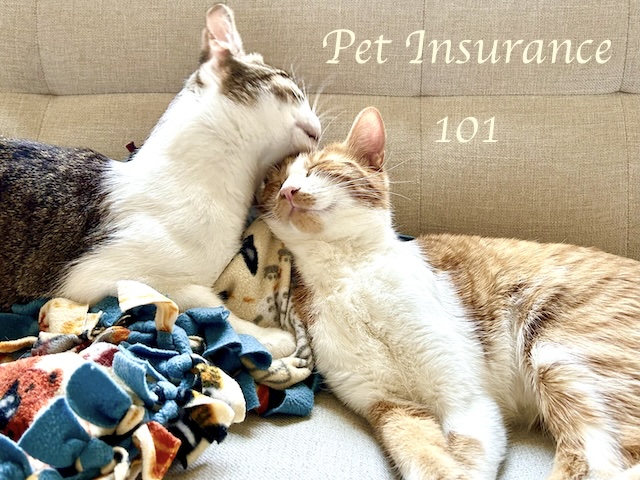

Do you have a smart and adorable furry friend at home? If your furry friend falls ill, it’s a cause for concern. Many pet owners have also wondered how to protect their pets’ health in the United States. Huhu has prepared a guide to US pet insurance, covering topics that pet owners care about most, such as what pet insurance covers, pricing factors, and precautions when purchasing pet insurance. I hope everyone’s furry friends stay healthy.
1. The Importance of Pet Insurance
In the United States, medical expenses have always been a considerable expense, especially for pets. Here are some reasons why you should buy pet insurance:
1. Pet health care costs are high in the United States
A basic veterinary visit for a dog is about $200, and for a cat, about $160. This price can even double for emergencies like sudden illness or injury .
2. The older the pet, the higher the cost
As pets age, the cost and frequency of care and illness increase , and the cost of treating some major illnesses can reach tens of thousands of dollars.
This situation is undoubtedly a financial burden for pet owners . High-quality pet insurance can save you from huge out-of-pocket expenses—which also means you won’t be forced to say goodbye to your pet because you can’t afford it. If you want to provide your pet with extra protection, click on pet insurance and purchase it now!
2. Pet Insurance Categories
How can you choose pet insurance to ensure adequate coverage? Pet owners can judge by two aspects: what the pet insurance policy covers and the pet treatment expenses covered .
In the United States, there are two types of items we can purchase for our pets: one is Pet Insurance and the other is Wellness Plan .
1. Pet Insurance:
Pet Insurance is used to cover veterinary expenses for diagnosis and treatment of unexpected conditions , such as injuries and illnesses. Each pet insurance company offers different plans, but generally they include:
1) Chronic diseases
Some older pets are prone to chronic diseases such as diabetes and osteoarthritis , and require regular check-ups. Therefore, it is very necessary to purchase pet insurance that can cover chronic diseases.
2) Prescription drugs
Some pet insurance plans also cover prescription medications. When your pet becomes sick or injured and needs prescription medication, pet insurance can help pay for the medication .
3) Pet diseases
If the pet insurance policy you purchase includes disease insurance, then the treatment costs for bacterial infections, allergies, cancer and other diseases that your pet may develop during its growth process will be covered.
4) Genetic diseases
Some hereditary diseases, such as heart disease, eye disease, and hip dysplasia, may not manifest until a pet’s later years. Purchasing pet insurance that covers hereditary and congenital diseases can be an additional benefit in addition to standard insurance.
5) Major unexpected medical expenses
When a pet has an accident, such as your cat or dog swallowing an unknown object or being bitten by another pet, the cost of X-rays, MRIs, blood tests, and other medical services performed at the veterinary hospital are covered.
This type of policy does not include routine preventive examinations, routine physical examinations and vaccination costs , and pet owners need to purchase additional supplementary pet health plans, also known as Wellness Plans.
2. Wellness Plan:
A Wellness Plan is not considered “pet insurance” in the true sense. It is intended for preventive care and daily health care , so it cannot replace regular pet insurance . A Wellness Plan typically includes:
• Blood, stool, parasite, and urine tests
• Waiver of outpatient fees
• Routine vaccinations
• Comprehensive pet checkup
• Nail trimming
• Teeth cleaning
• Health certificate
• Pest control and cleaning
• Sterilization
Small pets who are generally healthy and receive regular checkups should prioritize purchasing only the Wellness Plan , which can significantly save on insurance premiums. If your pet has been injured in the past or has a chronic condition that requires regular checkups and treatment, it’s best to purchase both plans to avoid exorbitant pet veterinary bills. Huhu recommends starting with a Wellness Plan for your puppy or kitten, then switching to Insurance as your pet grows older after vaccinations and spay/neuter procedures. However, the specific choice should be based on your pet’s individual circumstances.
Cat and dog insurance generally offer similar coverage, but dog insurance can be more expensive because veterinarians charge higher fees. In the United States, the average cost of dog insurance is approximately $18 per month (accident coverage only) or $50 per month (accident and illness coverage). The average cost of cat insurance is approximately $11 per month (accident coverage only) or $28 per month (accident and illness coverage).
What pet insurance doesn’t cover
In the United States, each company offers different pet insurance coverage, and most pet insurance plans may not cover the following :
1. Waiting Period
All pet insurance policies have a waiting period, most of which is 14 days . If something happens to your pet during the waiting period, the insurance company will not pay for it.
2. Pre-existing Conditions
Pet insurance doesn’t cover pre-existing conditions. However, some insurance companies will review medical records from the past 12 months and may be able to provide coverage if the pre-existing condition has been gone for at least a year .
3. Pregnancy & Labor Complications
Most insurance companies do not cover medical expenses incurred by pets during pregnancy and delivery .
4. Wellness Plan/Preventive Care
Preventative health care expenses for your pet are not covered , including but not limited to wellness exams, dental care, vaccinations, spay/neuter surgery, flea and heartworm prevention, etc.
5. Experimental Treatment
If your pet is seriously ill and cannot be cured by conventional treatment and requires experimental treatment, all costs incurred during the experimental treatment will be borne by you alone.
6. Obedience Training
If you want your pet to undergo obedience training to teach your dog basic behavioral instructions, you will need to pay for the training yourself.
7. Age Exclusion
Some pet insurance companies will refuse to provide pet insurance for puppies/kittens under 8 months old or senior dogs/cats over 14 years old. Of course, the specific age limit mainly depends on the type and breed of pet.
8. Behavior Issues
Only some pet insurance companies will cover the treatment and training costs for pets due to behavioral problems, and insurance companies will provide clear coverage limits for pet behavioral problems.
9. Congenital Anomalies/Developmental Disorders
Pet insurance companies will not cover congenital malformations or developmental disabilities caused by any factor . However, some pet insurance companies, such as the Odie Pet Insurance Plan , may cover congenital malformations or developmental disabilities if the symptoms are not obvious.
4. When should I buy pet insurance?
When insuring your pet, the younger the pet, the more cost-effective the insurance. Generally, pet insurance won’t cover illnesses contracted before the start of the policy . Once a certain illness has occurred, no insurance will cover it , and a recurrence will leave you with out-of-pocket expenses. Therefore , it’s best to purchase insurance as early as possible! Accidents and illnesses can happen at any time, making hefty veterinary bills a real possibility. Currently, most pet insurance plans in the United States cover 70% to 100% of expenses. If your pet is prone to serious, unexpected health issues, purchasing pet insurance is both worthwhile and necessary.
5. Factors Affecting Pet Insurance Prices
The main factors that affect pet insurance prices are:
1. Age: Older pets are generally more expensive to insure because they are more prone to health issues.
2. Gender: Male pets generally cost more to insure .
3. Breed: Cats are generally cheaper to insure than dogs; breeds that are more prone to health problems will cost more.
4. Where you live: Those who live in areas where veterinary care is more expensive will need to pay more for their pet insurance plan.
5. The pet’s working status: Some pet insurance companies charge more for working pets .
6. Coverage Choice: Plans that cover more health conditions will cost more than plans with limited protection.
7. Annual Maximum Limit: Most pet insurance plans have an annual maximum limit that limits how much the company will pay for your pet’s care. Choosing a higher annual maximum limit will increase your premium .
8. Reimbursement Percentage: Most pet insurance plans cover between 70% and 90% of covered treatment costs . Choosing a higher reimbursement percentage will increase your premium .
9. Deductible: Choosing a lower deductible will increase your pet insurance premiums .
Pet owners looking to lower their pet insurance costs should keep the following in mind:
1. Shop around: Every insurance company weighs risk differently , which is why they all give different quotes. The only way to know which one offers the best deal for a given pet is to set aside some time to get quotes and compare them.
2. Take advantage of discounts: Pet owners who believe they qualify for any of the above discounts should look for a pet insurance company that offers them.
3. Choose a lower reimbursement percentage: Choosing a lower reimbursement percentage will reduce premium costs but increase out-of-pocket expenses when making a claim.
4. Choose a higher deductible: Raising your deductible will also lower your monthly premiums, but at the same time, owners must be prepared to pay higher out-of-pocket costs if their pet becomes ill.
6. Things to note when purchasing pet insurance
When buying pet insurance, just like buying other insurance, you need to pay attention to the following points:
1. Carefully review each policy clause to confirm whether the insurance will cover the medical services needed by your pet and whether the deductible is a one-time or annual deductible.
2. Compare prices before making a purchase . In addition to comparing prices, pay more attention to the insurance company’s after-sales service (especially the efficiency of compensation and communication).
3. Pet insurance plans from different US insurance companies typically have a waiting period of 14 days to one month . Bills incurred during or before this period will not be reimbursed. Furthermore, if a pre-existing condition is considered a condition, subsequent similar illnesses will not be covered . Therefore, it’s important to pay attention to the length of the waiting period when purchasing insurance.
7. Recommended pet insurance in the United States
When purchasing pet insurance in the United States, it’s crucial to find a reliable insurance company, as they offer appropriate coverage and smooth claims processing. Currently, the following reputable pet insurance companies in the United States include: Pumpkin, Spot, Lemonade, Trupanion, Embrace Pet Insurance, Pets Best, Healthy Paws, Nationwide, Figo, and Fetch by The Dodo.
Each pet insurance company offers its own unique features. For example, Pumpkin offers extensive coverage, Spot offers unlimited coverage, Lemonade offers the best value, Trupanion covers congenital and breed-specific conditions, Embrace Pet Insurance offers a short waiting period, Pets Best offers a simple claims process, Healthy Paws offers no annual or lifetime restrictions, Nationwide offers a variety of plans, Figo offers efficient claims processing, and Fetch by The Dodo offers a variety of benefits and discounts. Therefore, Huhu recommends carefully comparing the prices, terms, and customer feedback of each policy to choose the best policy for your pet.
Reference:
hhttps://www.moonbbs.com/thread-1553333-1-1.html



